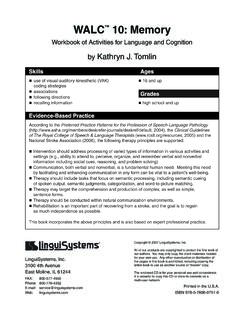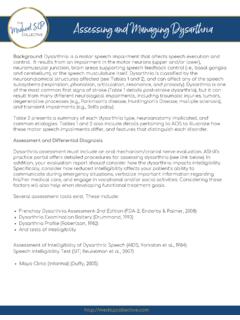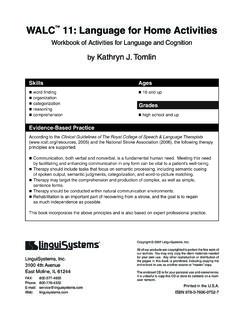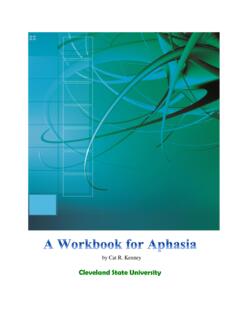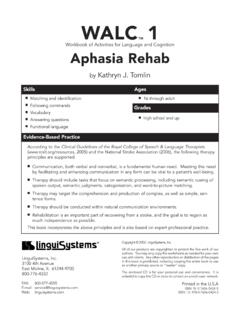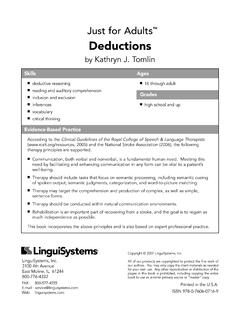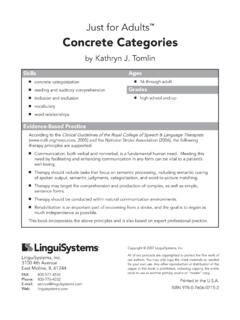Transcription of Just for Adults Yes/No Questions
1 Just for Adults Yes/No Questionsby Kathryn J. TomlinSkills reading and auditory comprehension vocabulary language word relationshipsEvidence-Based PracticeAccording to the Clinical Guidelines of the Royal College of Speech & Language Therapists ( , 2005) and the National Stroke Association (2006), the following therapy principles are supported: Communication, both verbal and nonverbal, is a fundamental human need. Meeting this need by facilitating and enhancing communication in any form can be vital to a patient s well-being. Therapy should include tasks that focus on semantic processing, including semantic cueing of spoken output, semantic judgments, categorization, and word-to-picture matching. Therapy may target the comprehension and production of complex, as well as simple, sentence forms. Therapy should be conducted within natural communication environments.
2 Rehabilitation is an important part of recovering from a stroke, and the goal is to regain as much independence as book incorporates the above principles and is also based on expert professional 16 through adultGrades high school and upLinguiSystems, 4th AvenueEast Moline, IL 61244 FAX: 800-577-4555 Phone: 800-776-4332E-mail: 2007 LinguiSystems, of our products are copyrighted to protect the fi ne work of our authors. You may only copy the client materials as needed for your own use. Any other reproduction or distribution of the pages in this book is prohibited, including copying the entire book to use as another primary source or master enclosed CD is for your personal use and convenience. It is unlawful to copy this CD or store its contents on a multi-user in the 978-0-7606-0719-0 About the AuthorKathryn J. Tomlin, , CCC-SLP, has been a speech-language clinician in hospitals, rehabilitation centers, and in long-term care facilities for over 25 years.
3 She has authored many materials with LinguiSystems over the last 20 years. Some of her works include:WALC 1 ( workbook of Activities for Language and Cognition) aphasia RehabWALC 2 Cognitive RehabWALC 8 Word FindingWALC 9 Verbal and Visual ReasoningWALC 10 MemoryWALC 11 Language for Home ActivitiesThe Source for Apraxia TherapyZanmi, Kathy s Samoyed, goes to work with her to encourage the clients. Her clients enjoy feeding and spending time with Zanmi, and Zanmi enjoys their company. Everybody wins!DedicationThis book is respectfully dedicated to Danielle Fedele. Thanks for all your help in using the exercises in this series of books. I couldn t have done it without you. May your journey in the world of speech/language pathology be fulfi lling and by Lauri WhiskeymanPage Layout by Christine BuysseCover Design by Jeff TaylorIllustrations by Margaret WarnerKathy and her therapy dog, ZanmiJust for Adults : Yes/No Questions 3 Copyright 2007 LinguiSystems, of ContentsIntroduction.
4 4 Screening .. 6 Short Questions .. 7 Object Questions .. 10 Safety Questions .. 12 Food Questions .. 13 Household Questions .. 14 Animal Questions .. 15 Yard and Garden Questions .. 16 Occupation Questions .. 17 General Yes/No Questions .. 18 Two Item Comparisons .. 23 Picture with Questions .. 27 Before and After Questions .. 29 Before and After Questions with Pictures .. 31 One Sentence with Question .. 32 Two Sentences with Question .. 34 Paragraph with Questions .. 36 Answer Key .. 39 Just for Adults : Yes/No Questions 4 Copyright 2007 LinguiSystems, Yes/No Questions is an integral part of our communication. We ask and are asked Yes/No Questions every day. But the ability to answer these Questions is frequently impaired in someone who has language or thinking diffi factors can hinder one s ability to comprehend or answer these kinds of Questions correctly, such as: Diffi culty understanding language or concepts due to aphasia .
5 Impulsivity or decreased attention skills causing one to answer before reading or hearing the entire question. Fixation on giving all yes or all no responses. Diffi culty with manipulating/comparing information when thinking. Tendency to fi xate on exceptions to the most common exercises in Just for Adults : Yes/No Questions address several levels of comprehension of Yes/No Questions and begin with the easier level at the beginning of the book and progress to a harder diffi culty level. The tasks can be given orally, can be read and done independently, or can be read by a presenter while the client is reading the question. When done graphically, the tasks require circling or marking the yes or no page 6, you will fi nd a screening tool that is not to be used as a test but rather as a way to observe a client s use of strategies and reasoning patterns.
6 Some Questions to think about while observing how the client completes the screening include: 1. Does the client need to use verbal rehearsal to aid comprehension? 2. Is the client impulsive, and does his impulsivity lead to errors? 3. Does the client read too much into the task and become confused? 4. Is the client aware of his error responses? 5. Does the client ask for clarifi cation when having diffi culty or does he just keep going, whether the item is understood or not? 6. Does the client miss salient information? 7. Is the client able to think convergently and divergently? 8. Does the client have trouble shifting from one task to the next?These guidelines will help you present the activities in this book. A CD of the exercises in this book is included inside the back cover. You can photocopy the pages as needed or print them directly from a printer using the for Adults : Yes/No Questions 5 Copyright 2007 LinguiSystems, Inc.
7 The goals of these exercises are to improve attention, mental manipulation of information, and for comprehension of words and concepts. Be fl exible with presentation and accept answers that are different from your viewpoint if the client can give a logical explanation. The answers in the Answer Key are provided as a reference and are not intended to be all inclusive. The exercises are not for testing purposes. Try to make doing them as enjoyable as possible. Talking about the Questions , particularly when correcting error responses, will likely improve the ability to achieve the goals. Do not get into debates if the person is unable to see another viewpoint for a response. Just move on to the next item. Be fl exible with presentation and with accepting answers that differ from your viewpoint if a logical explanation can be provided by the person.
8 But there is a caution: You will frequently have to remind the client to answer the Questions in general as it is human nature to try to think of the one or two exceptions and then generalize it to distort the best answer for that hope you and your clients fi nd these exercises enjoyable and benefi cial. KathyIntroduction, continuedJust for Adults : Yes/No Questions 6 Copyright 2007 LinguiSystems, the correct answer. 1. Can a dish break? .. Yes No 2. Is a knife used to cut air? .. Yes No 3. Can an omelet be eaten for breakfast? .. Yes No 4. Does a cat purr when it is angry? .. Yes No 5. Does a teller wait on you in a bank? .. Yes No 6. Does a submarine travel in the sky?
9 Yes No 7. Is your arm longer than your leg? .. Yes No 8. Do you chew food before you swallow it? .. Yes No 9. I have a sore arm. Is my arm hurting? .. Yes No10. I went to the doctor on Wednesday afternoon. He told me that I was very healthy. He said I should come back in six months. I thanked him for his time and Did I go to the doctor on Wednesday morning? .. Yes Nob. Did the doctor say I was sick? .. Yes Noc. Was the doctor a man? .. Yes Nod. Did he say I should return in one year? .. Yes Noe. Did he give me any new prescriptions? .. Yes NoJust for Adults : Yes/No Questions 7 Copyright 2007 LinguiSystems, QuestionsMark the correct answer. 1. Can hands clap? .. Yes No 2. Can a chair walk? .. Yes No 3. Can a belt be tightened?
10 Yes No 4. Are glass windows breakable? .. Yes No 5. Should teeth be brushed? .. Yes No 6. Can bicycles f ly? .. Yes No 7. Do radios have pictures? .. Yes No 8. Are mountains small? .. Yes No 9. Can a bed be soft? .. Yes No10. Do people wear shoes? .. Yes No11. Are feathers light in weight? .. Yes No12. Do people drink water? .. Yes No13. Can a phone cut paper? .. Yes No14. Can a boat fl oat? .. Yes No15. Does a rock produce light? .. Yes NoJust for Adults : Yes/No Questions 8 Copyright 2007 LinguiSystems, QuestionsMark the correct answer. 1. Do pencils contain ink? .. Yes No 2. Do you drink a sandwich? .. Yes No 3. Is money worthless? .. Yes No 4. Are shovels used for digging? .. Yes No 5. Are towels scratchy?
